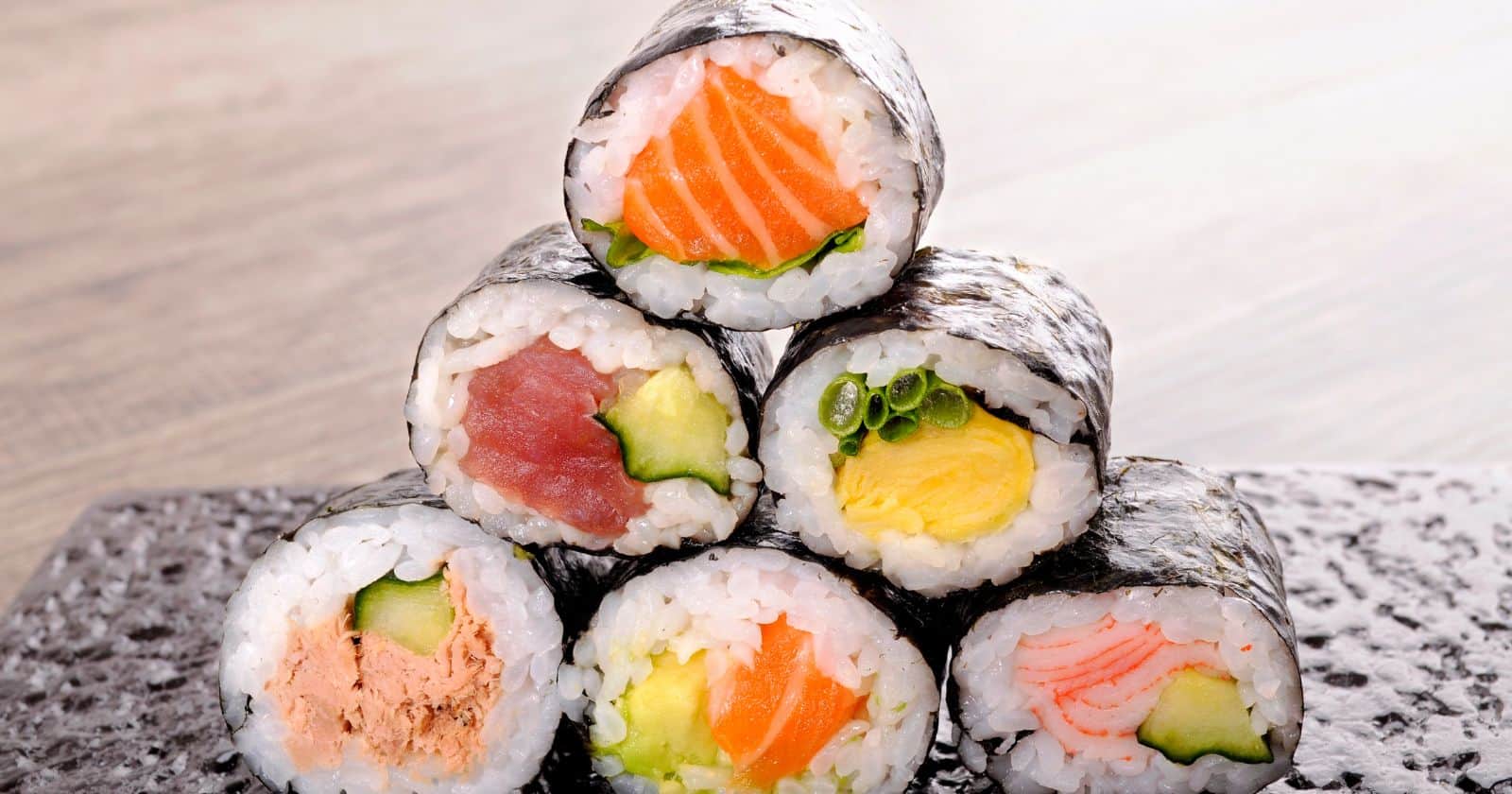Is sushi wrapped in seaweed? For the most part, yes – sushi is commonly wrapped in edible seaweed sheets called nori.
Hello curious foodies! If you’ve picked up a piece of sushi and wondered what that dark green wrapping is, you’ve come to the right spot. As a sushi enthusiast, I’m excited to share the fascinating facts on the seaweed wrap that holds sushi together.
While delicate sushi fillings like raw fish, vegetables, and rice require an encasing, the Japanese found the perfect solution in nutritious nori seaweed sheets. Here’s the lowdown on this oceanic wrapper:
- Nori is a type of edible seaweed that’s dried and pressed into wafer-thin, rectangular sheets. It has a salty umami taste.
- With sushi, nori is wrapped around rice and fillings to form rolls or used under nigiri toppings. It holds ingredients together.
- Nori contains healthy minerals, vitamins, protein and fiber. It has very few calories so it won’t weigh your sushi down!
While nori seaweed is the traditional and most common sushi wrapper, some modern rolls use soy paper, cucumber or egg wraps instead. But you can’t go wrong with the classic taste and nutrition of nori!
Curious to learn more about edible seaweed wraps for sushi? Keep reading as I dive into the different types, flavors, origins and uses for nori. You’ll be a sushi wrapping expert in no time!
Nori Seaweed is the Most Common Sushi Wrapper
When you pick up a piece of sushi, chances are you’ll notice a wrapper of thin, crinkly dark green seaweed enveloping the rice and fillings. This traditional sushi wrapper is called nori, made from edible red algae that’s dried and pressed into sheets.
Nori has been used to wrap sushi for centuries in Japan. Here’s what you need to know about this seaweed:
- It has a dark green to black color when dried into paper-thin sheets.
- The flavor is subtly salty, briny, and umami – perfect for pairing with rice and fish.
- Nori’s papery yet pliable texture makes it easy to roll tight sushi rolls without ripping.
- It contains protein, fiber, vitamins, and minerals while being very low in calories.
- Nori is commonly toasted before using to enhance flavor and crispness.
So when you see that iconic dark green wrap holding sushi together, you can bet it’s wholesome, nutritious nori seaweed!
Nori Holds Fillings in Place
Nori is the ideal wrapper for sushi because it’s sturdy enough to hold fillings neatly in place without falling apart. As you pick up sushi pieces with your fingers, having an enclosing wrapper prevents the rice and ingredients from spilling out.
The dried nori sheets lend sturdiness while also remaining pliable, allowing for tight rolls. The wrapper conforms to encase the contents securely.
Nori also helps:
- Keep the moisture in so sushi fillings don’t dry out
- Prevent sogginess by separating wet fillings like fish from the rice
- Allow for cylindrical shaping or creative inside-out rolling
So nori is clearly the MVP when it comes to keeping sushi tidy, intact and delicious!
Other Potential Sushi Wrappers
While nori seaweed is the long-standing traditional favorite, some modern sushi rolls make use of creative wrappers like:
- Soy paper – translucent and edible like nori but more tender.
- Cucumber – for a light crunch and moisture. Often wrapped around cream cheese fillings.
- Tamago – sweet folded Japanese omelette that wraps tamago sushi.
- Shiso leaf – bright green, peppery leaf used in hand rolls.
- Avocado – for vegetarian maki with an ultra-soft wrapper.
However, none possess the perfect combination of flavor, nutrition and functionality like nori. These creative wrappers make occasional appearances but most sushi adheres to the tried-and-true nori seaweed wrap.
Nutritional Perks of Nori
Beyond just holding sushi together, nori seaweed contributes beneficial nutrients and minerals for health. Here’s what’s inside those thin green sheets:
- Protein – nori has up to 25-50% protein. The amino acids are complete proteins.
- Fiber – hard-to-digest carbs act as prebiotic fiber when eaten.
- Vitamin C – important for immunity and wound healing.
- Vitamin A – nori is one of the best plant sources of this vision-supporting vitamin.
- Iodine – crucial for thyroid hormone function and metabolism.
- Iron – prevents anemia and supports blood and muscle health.
- Calcium – for strong bones, around 10% DV per sheet.
Plus nori provides a spectrum of other minerals like zinc, manganese, copper and potassium. All that from a light, edible seaweed wrap!
Trying Different Nori Sushi
Want to appreciate the flavor and function of nori in sushi? Pick up some nori sheets and experiment with wrapping your own sushi creations!
- Make basic rolls with rice, veggies, salmon, tuna etc.
- Roll inside-out uramaki sushi to showcase the nori outside.
- Prepare temaki hand rolls for easy snacking.
- Wrap nigiri pieces to hold rice and fish toppings.
You can also seek out alternative wraps like soy paper or cucumber at modern sushi bars. But the quintessential nori seaweed roll remains a tasty treat.
Now that you know sushi is reliably wrapped in nutritious nori, you can enjoy this edible wrapper knowing it keeps your sushi secure and addsmarine nutrients. From its health perks to functionality, flavor and appearance, nori truly is the gold standard for encasing sushi!





